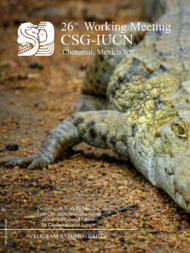Population genetic structure in Paleosuchus palpebrosus: a novel Management Unit from the Brazilian Cerrado biome.
Population genetic structure in Paleosuchus palpebrosus: a novel Management Unit from the Brazilian Cerrado biome.
Author(s): MUNIZ, F.; CAMPOS, Z.; POLO, E.; FARIAS, I.; HRBEK, T.; HERNÁNDEZ-RANGEL, S.
Summary: To investigate the spatial distribution of the genetic diversity of widely distributed species is important to prevent that genetically structured groups are neglected from the conservation point of view. In a previous study, we identified four conservation units of Paleosuchus palpebrosus, three Evolutionarily Significant Units (ESUs): 'Amazon'(A), 'Madeira-Bolivia' (MB) and 'Pantanal' (P), and two Management Units (MU) within MB: 'Madeira' (M) and 'Bolivia' (B). In this study, we expanded sampling geographically and sequenced the mitochondrial cytochrome b gene from 151 additional individuals, totaling 357 sequences, aiming the investigation of additional genetically structured lineages of the P. palpebrosus species complex and their genealogical relationships to the other previously-identified lineages. Cluster analysis in BAPS allowed us to detect a genetically structured population apart from those previously found, whose geographical distribution comprises mainly the Brazilian Cerrado biome, so we will name it 'Cerrado' (C). Haplotype network revealed that C is most closely related to P lineage and phylogenetic reconstruction showed that this group is not monophyletic. When we plotted the BAPS result on the map, all individuals from the Paraná River basin and upper Tapajós River basin pertained to cluster P, along with the population from upper Paraguai. When we plotted the BAPS result on the map, all individuals from the Paraná River basin and upper Tapajós River basin pertained to cluster P, along with the population from upper Paraguai. We observed sympatry in only four localities of the 45 localities where individuals of either the C or P clusters occur, suggesting either retention of ancestral polymorphism or gene flow between populations. The genetic divergence of the C and P clusters, with the exception of few localities a non-overlapping distribution and non-monophyly in mtDNA indicate that this population should be treated as an MU and together with the 'Pantanal' MU it makes up one ESU. The uniqueness of 'Cerrado' MU must be taken into account in future studies, to guide conservation and management decisions and risk assessment of the P. palpebrosus species complex.
Publication year: 2022
Types of publication: Abstract in annals or event proceedings
Unit: Embrapa Pantanal
Observation
Some of Embrapa's publications are published as ePub files. To read them, use or download one of the following free software options to your computer or mobile device. Android: Google Play Books; IOS: iBooks; Windows and Linux: Calibre.
Access other publications
Access the Agricultural Research Database (BDPA) to consult Embrapa's full library collection and records.
Visit Embrapa Bookstore to purchase books and other publications sold by Embrapa.

